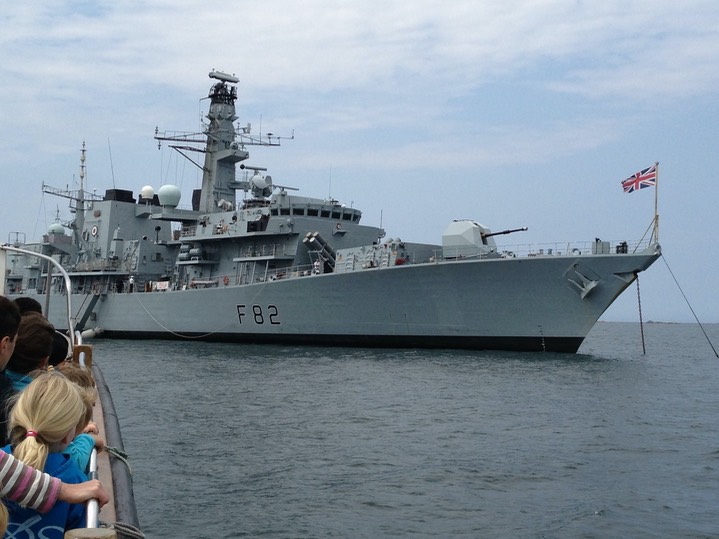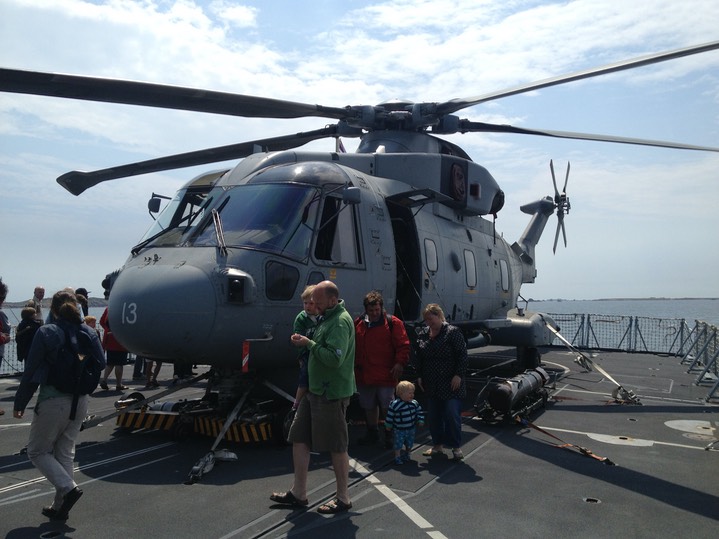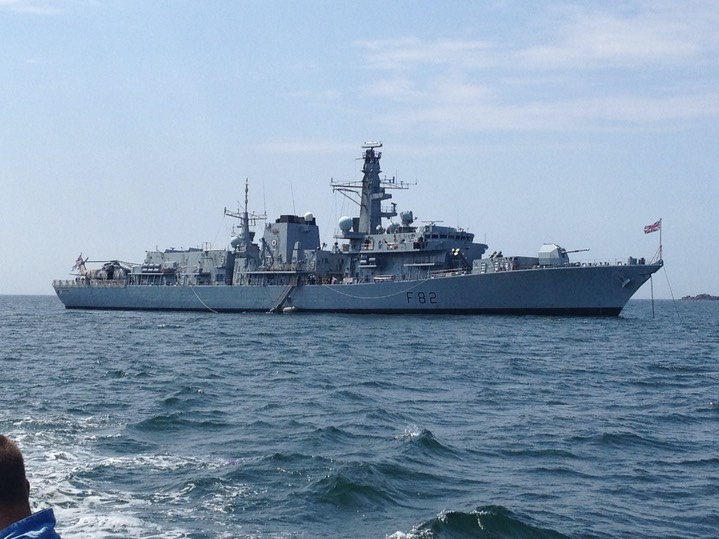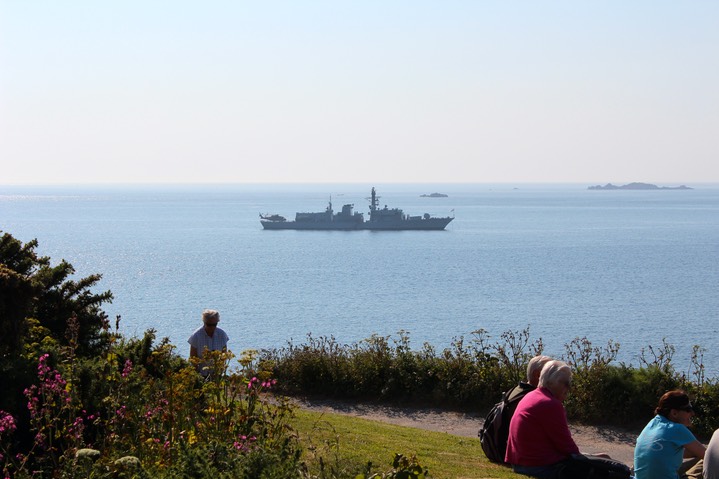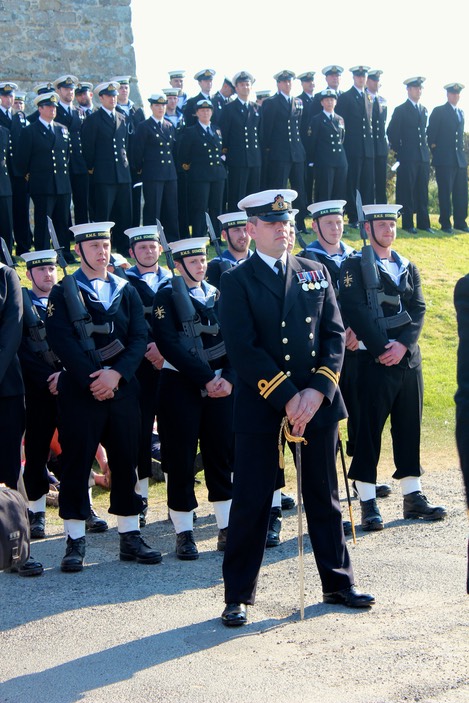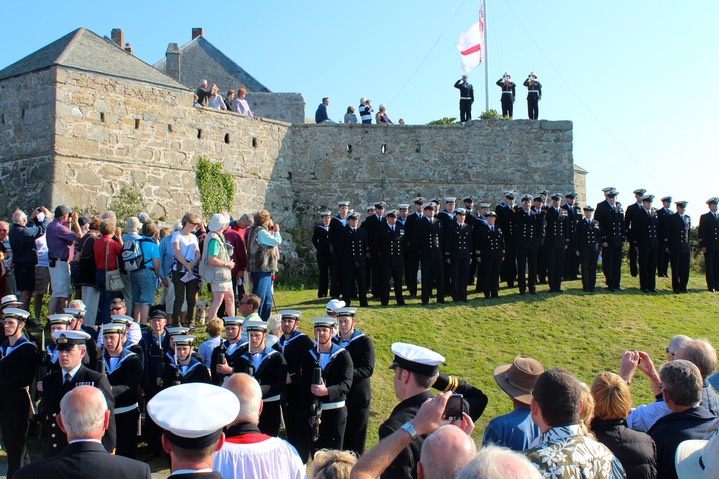Last weekend saw HMS Somerset visit the Isles of Scilly. She is a submarine destroyer Type 23 frigate and, taking a break from Operational Sea Training, was here to celebrate the 70th anniversary of the "Battle of the Atlantic". She was here for 3 days and kindly offered tours of the ship to visitors and locals alike. We toured the ship and very interesting it was too!
For those of you interested in the history of the "Battle of the Atlantic" I have added below an outline of the events. Below that are is a photo or two of mine from the weekend. The ones in front of Star Castle are of the "Sunset" presentation of the commemoration.
"The Battle of the Atlantic"
The Battle of the Atlantic was the longest continuous military Campaign in World War II, running from the outbreak of war in 1939, until the defeat of Germany in 1945. The initial Allied blockade of Germany denied them vital war materials but had little effect on German industry. Germany's 57 submarines (U- boats) were small and short ranged, and initially the British convoy system ensured our merchant ships crossed the Atlantic unscathed. Gradually, the Germans built larger, long-range submarines and the tables were soon turned against us.
With the fall of France in 1940, Britain lost not only its biggest ally but also the support of the French Navy, then the 4th largest in the world. Operating from Norwegian and French ports, the German Navy now had direct access to the Atlantic both north and south of the British Isles. New German submarines were now capable of patrols into mid Atlantic, attacking convoys where once they had been safe.
As an island nation, the United Kingdom is highly dependent on imported goods. Britain required more than a million tons of imported material a week in order to survive, and wage war. In essence, the Battle of the Atlantic was a war of merchant ship tonnage; the Allies struggling to supply Britain and Germany trying to stem the flow of ships that enabled the British to keep fighting, without which the only alternative was to surrender.
June and September 1940, in 92 days, U-boat crews sank 270 Allied ships, almost three a day! Churchill himself later wrote of this period, " . . . the only thing that ever frightened me during the war was the U-boat peril."
Nor were the U-boats the only threat, since from 1940 onwards German aircraft flying from French bases, carried out long range reconnaissance missions to find Allied convoys, communicating their positions to surfaced German submarines. Additionally, Fw200 Condor and Junkers Ju290's aircraft regularly bombed convoys as they reached the Western Approaches, claiming 365,000-tons of shipping in 1941 alone.
U-boats had until now made individual attacks on Allied convoys but then the Kriegsmarine, under the command of Vizeadmiral Karl Donitz changed its tactics, working as RudeIn or wolf-packs, coordinated by radio. German code breakers had succeeded in deciphering the British Royal Navy Cypher code No.3, allowing the enemy to estimate where and when convoys could be expected. The U-boats would then spread out in a long line abreast, covering hundreds of miles, and the submarine that sighted a convoy would report to U-boat headquarters. That boat then shadowed the ships until other submarines arrived, who would then attack simultaneously, usually at night. With the U- boats attacking on the surface and within the lines of ships, escort vessels ASDIC (anti-submarine detection equipment) was impotent, and with early radar lacking discrimination and range, the submarines were difficult to locate. Additionally, escorting corvettes were too slow to catch a surfaced U-boat, and often did not join convoys until ships where within easy reach of Ireland.
In the spring of 1941 Dönitz lost three leading captains and their crew when their U-boats were sunk attacking Convoy HX112. The enemy then moved its wolf-packs further west, catching convoys before anti-submarine escorts could join them, and that April ten merchant ships in Convoy SC26 were lost.
Escort warships were now provided for the full duration of a north Atlantic crossing, assisted initially by the Royal Canadian Navy, then the Free French, Norway and the Netherlands. The United States then declared war on both Japan and Germany in 1942, giving Dönitz cause to order attacks on vessels close to the American eastern seaboard, sinking 156,939-tons of merchant shipping there in five weeks.
U-boats in general caused the loss of 397 ships, over 2 million tons, that year alone. To combat losses the US built and launched over 11 million tons in 1943. In one month the allies lost 120 ships worldwide, 82 of them in Atlantic convoys. Just as Britain was seriously considering abandoning convoys completely, and feared being unable to continue the war, the situation changed following the success of Convoy ONS5 in 1943. Thirty U-boats attacked 59 ships, but six submarines were sunk, with a further five two weeks later, and after losing a total of 43 in May, Donitz recalled all his Atlantic boats admitting, "We have lost the Battle of the Atlantic. "The Allies were saved by new inventions, technology and the fact the USA could build ships quicker than the Germans could sink them. ASDIC was a major contribution, as was radar, high-frequency direction finding, the Hedgehog mortar system and sister weapon Squid, aircraft Leigh lights, and the breaking of the German Enigma code, all finally gave the Allied Navies the edge.
For both Merchant Navy and Royal Navy crews the trans-Atlantic voyages were hell-on-earth. They lived, worked, fought, ate and slept in constant fear of being torpedoed at any moment, day or night, either ending up in the freezing sea or a lifeboat. The men slept fully dressed, with lifejackets within reach, never sure what the next hour would bring, and no sooner was one voyage over, than they embarked on the next. They watched torpedoed tankers vanish in seconds in massive fireballs, ships break their back and vanish in as little as a minute, and they steamed past countless men swimming in the sea covered in thick furnace oil, afraid to stop and pick them up in case they too were torpedoed.
What part did the Isles of Scilly play in the Battle of the Atlantic? Scilly is the most south-westerly point of the United Kingdom and in WW2 the islands played a vital role as an Allied base on the Eastern fringe of the Atlantic. Ships that had been torpedoed but remained afloat, were frequently dragged into St. Mary's Roads by deep-sea rescue tugs, then patched up and escorted to• mainland ports such as Falmouth. If a vessel was attacked and sunk, then the St. Mary's lifeboat would be called out to try and save life. In 1940 the RNLI.Caroline Oates Aver & William Maine, was sent to a position 60 miles SE of Scilly to help the torpedoed Dutch ss.Burgerdijk, running out of fuel on the way back having covered 135 miles, a record at the time. In 1941 they landed 10 men and a body from the ss.Kia, and the arrival of ship's lifeboats on the islands containing survivors was common place. The men received treatment from the many doctors, nurses and medical staff, some 27 in total, here at the hospital. The Royal Navy Patrol Service had vessels in the harbour, along with ML's, RIVIL's and occasional MTB's (armed motor launches and motor torpedo boats) that met convoys as they approached the islands, whilst RAF high-speed launches HSL's) went out to pick up Allied or enemy aircrew from crashed aircraft. Sunderland flying boats from RAF Mountbatten, Plymouth, undertook long range anti-submarine patrols into the Atlantic. Scilly frequently offered them a safe haven when they were in trouble or short of fuel, whilst Hurricane aircraft stationed at St. Mary's airfield would attack enemy aircraft in the vicinity. RAF. Newford was an important Ground Controlled Interception tan early type of radar) station at High Lanes,), Deep Point and the Garrison Woolpack housing homing beacons for aircraft returning from Atlantic patrols. A total of 10 U-boats were sunk within 40 miles of Scilly during the war, eight in two months in 1945.
Between 1939 and 1945 the British Merchant Service lost 3,500 ships (14.5 million tons gross) and over 31,000 men; the Royal Navy 63,787 men and 1,503 warships. Germany lost 783 U-boats and approximately 30,000 men, three-quarters of her 40,000-man U-boat fleet.
